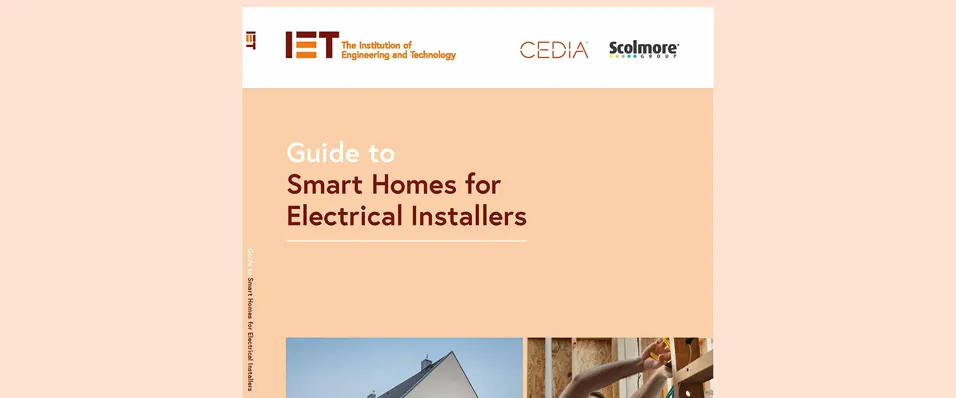
With great power comes great responsibility
Domestic and commercial customers are now very aware that there are a host of devices and equipment that can swap out the ‘traditional’ item and offer them greater functionality. These options are increasingly on a par in terms of price, room thermostats being a good example, where Internet of Things (IoT)/Wi-Fi versions are really not much more expensive than their older, physical-button relations.
However, an uncomfortable truth about ‘smart’ for electricians is that most manufacturers will design devices so that electricians are not needed whenever that is a safe option. This is simple economics as they will sell more units if the cost of ownership is lower. Online product reviews condense hundreds of hours of trial and error into summaries that can be read in minutes, so the electrician’s product knowledge is trumped in most cases. QR codes and YouTube videos to simplify installation and setup will improve so devices with digital interfaces will become increasingly user-configurable.
So, should the humble electrician give up on the hope of being required or relevant anywhere outside of pulling cables or chopping out a back-box?
Answering this requires consideration of two very general factors of electrical installation; coverage and longevity.
In terms of coverage, in my experience as an installer, no other trade gets in as many places, with as many bits, making as many holes, and linking all those places as the electrician.
As to the longevity, the lifespan of an electrical installation is decades. Customers expect that they don’t want the disruption of a rewire more than once in a generation. Let’s say 30 years, that takes us to 2051.
So as the trade going everywhere and linking everything in a given building, you, the electricians are the best-placed people to cover off all the likely connectivity requirements of the building for the next 30 years. By 2051 we can expect a profound transition in how people and buildings interact with each other and the increasingly endangered environment.
How can an electrician not be relevant in that scenario?
How should electricians approach this responsibility?
Not every electrician will want to step into the role of ‘future-readier’.
Some will already have grasped the crystal ball. For those thinking maybe they should but wondering how to shape it into something that works and can be invoiced, I offer three simple steps to get started:
Step 1
Notice trends, particularly those that take significant current.
Some examples:
EV charge points. They’ve been coming on slowly for 10 years - then all-of-a-sudden if you didn’t put at least a 6mm cable from the origin into the garage or near the drive you’re a lemon!
Battery energy storage is another slow burn. It is possible we will all end up using our cars as batteries but what if we don’t, where would a static battery go and how would it be connected?
PV could become cheaper, easier and better incentivised, is a cable to a sunny surface justified?
Electricians don’t just do power cables. Communication and bandwidth requirements are just going up and up. But so are concerns about screens and their effect on mental health. Is it possible wide-coverage Wi-Fi will become less popular in favour of wired outlets and low-power Wi-Fi? Do you need to specify CAT cables to allow for this?
DC power that we have seen expand as USB and USB-C is likely to increase in availability and capability as renewable DC and battery energy becomes better integrated. We could be seeing DC white goods in high street electrical retailers before the decade is out. Do some final circuits need to be earmarked for later adaptation to DC?
Step 2
Consider lifestyle.
No one is suggesting you need to become a behavioural scientist or interior designer but do bear in mind that there is an interplay between your installation and the building and between the building and the homeowners.
In addition to guidelines, like those found in the IET’s On-Site Guide, which recommend minimum levels of sockets in different room types - take the time to find out how home dwellers live and use the space you are installing in and try to anticipate future requirements.
The term prosumer describes people who look to leverage their energy assets for financial benefit. Until recently it has been a bit niche but, for all we know, being a prosumer might become a necessity within 10 years. This being an example of a lifestyle change that might be thrust upon your client, a new build or rewire is an opportunity to work in the capability to prosume.
Importantly, consider how the client's lifestyle will change as they age. Putting it bluntly, the cost of residential care is a strong incentive to optimize the home so that owners can stay in it longer. Assistive living technology is a rapidly developing market. It is another digital trend that could have been listed in Step 1 above. The form and shape of solutions is highly fluid and will require research, but it is something electricians should explore and discuss with their clients.
Step 3
Take reasonable steps and adopt reasonable strategies, including:
Ducting
It is cheap and if a channel is open e.g. a trench, a wall, a floor that goes in a direction that might yield a benefit or possibility, put some ducting in it.
Nodes
Just because there is a duct does not mean pulling a cable through is going to be possible. Consider claiming nodes which break up ‘pulls’ and potentially create space for junctions and equipment in the future. At this point you are stepping into a mode that affects the work of others to a degree they might not be accustomed to (or like). Asking a chippie to create an access hatch where they planned to nail a bit of ply could be controversial, be prepared to explain benefits to other interested parties. The prospect of convincing others leads me on to my final recommendation.
Learn and inform
With great power comes great responsibility. The built environment’s conversion to electrification and digitalization will continue to accelerate and electricians will be in the vanguard of that transition. Take the time and make the effort to become informed about how the way you structure your installation can enhance the user experience and minimize the environmental impact of the places you’re designing for.
You don’t need to have all the answers, but be ready to argue for that extra hatch, duct, cable or just cable cross-sectional area. The client, architect and other trades will have their own preferences and big picture, but you are the one who knows how to connect things up. If you are getting in every nook and cranny, make it count by making a better, more sustainable building for a better world.

Allan Burns BSc TMIET PGCE
Allan Burns is the Author of the IET Guide to Smart Homes for Electrical Installers where you can find more guidance on how to deep-design smart sustainable homes.
